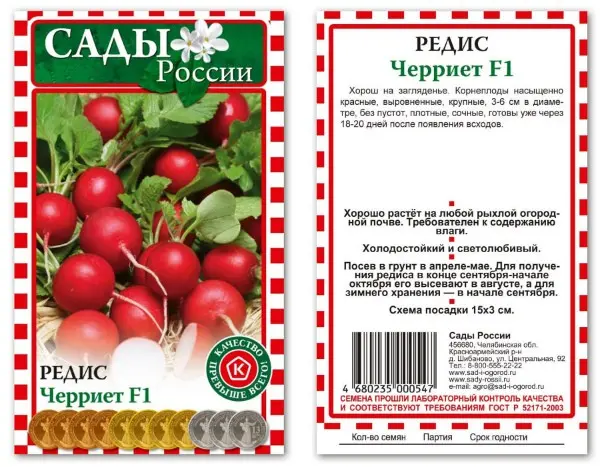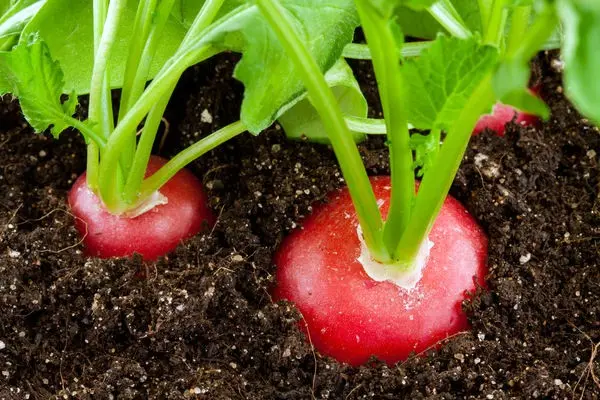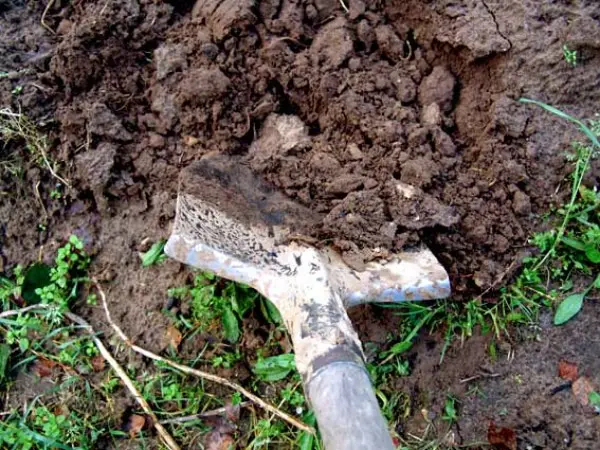Contents
Cherryat F1 radish is an early maturing hybrid of Dutch selection, suitable for year-round cultivation. Possessing excellent taste and commercial characteristics, it quickly gained popularity among consumers and was soon included in the State Register as a vegetable recommended for cultivation in private household plots. Today Cherriet is sown by almost every vegetable grower, because it is perhaps the earliest variety among all the early ones. How to grow a foreign hybrid in our latitudes, as well as its description, is presented in this article.
Description and characteristics
Cherriet is a hybrid form of early ripening radish. In favorable conditions and subject to agricultural practices, the first crop can be harvested 16–18 days after emergence. Like most varieties of Dutch radish selection, it has a high immunity to cold and easily adapts to any climatic conditions. Under film cover, radishes can be grown from early spring to late autumn. In winter, the culture grows well in greenhouses, but the ripening period is slightly delayed due to lack of daylight.

The advantages of the variety include high resistance to diseases and damage, the absence of voids in root crops, even when overgrown. It should also be noted that plants are not prone to the formation of arrows with peduncles. They have a compact leaf rosette, and therefore radishes can be planted more densely than other varieties, which saves planting area.
Hybrid Cherriet is highly valued by vegetable growers and consumers for its excellent taste and good marketability. Root crops of this variety are distinguished by a surprisingly even surface, the same rounded shape and a skin of intense scarlet color. The pulp of root crops is white, dense, very juicy, medium spicy taste. The size of root crops at harvest maturity reaches 3–4 cm, but with good care they can grow up to 5–6 cm. The average fruit weight is 25–30 g, large specimens reach 40–45 g. refrigerator can lie up to 1 month.

Peculiarities of growing
Cherriet radish is very cold hardy. It can be sown in a greenhouse or under a film at the end of March, and in open ground – as soon as the soil warms up a little, in early or mid-April. When planting radishes in the garden, try to place the bed in a sunny place, as in the shade the plants will grow long tops, which is not typical for this variety, and the root crops will be small.
For good yields, radishes need fertile and light soil. Well, if your garden is dominated by loose sandy soil with neutral acidity or slightly acidic – this is the most suitable soil for cultivation. If you have heavy soil, you need to add peat, river sand to it, to increase fertility – compost, humus, to reduce acidity – lime or ash.
Keep in mind, radishes do not tolerate fresh organic matter (litter, manure), as well as nitrogen mixtures.

Since the growing season of Cherryat radish is short, it does not need additional feeding – as a rule, the fertilizers that were applied during soil preparation are sufficient. If the radish seems to be growing poorly, water it with a solution of ash (1 cup / 10 liters of water). The ash contains potassium in an easily accessible form, which contributes to the rapid filling of root crops and improves their taste.
As for planting, the seeds of this variety can be sown without pre-soaking, as their germination is very high. It should be sown to a depth of no more than 1,5 cm. If the seeds were sown densely, they are thinned out after germination, leaving a distance of about 5 cm between seedlings. Radishes are moisture-loving, so you need to make sure that the soil at a depth of 8-10 cm is always wet. The optimum temperature for the development of root crops is +16–20 °C.
Flea protection
As mentioned above, Cherriet radish has a high immunity to damage and many diseases, in particular fungal ones. However, its young leaves are very often affected by the cruciferous flea – black bugs jumping along the bed with shiny backs. The parasite belongs to the family of leaf beetles, it devours young leaves in the upper layer, which, of course, affects the condition of plants and often leads to the destruction of the entire garden.

It is impossible to use insecticides for radishes, since root crops quickly accumulate these chemicals in themselves, so folk recipes remain the only way to deal with a flea.
For spraying plants, you can prepare the following medicinal liquids:
- vinegar solution (1 tablespoon of essence per 5 liters of water) – the leaves are sprayed on both sides in the afternoon or evening, when there is no sun and wind;
- tomato-garlic infusion (0,5 cups of chopped garlic and tomato tops per 5 liters of warm water) – leave for 3 hours, strain, add a quarter of a piece of grated laundry soap, spray the garden bed at the rate of 1,5 l / 1 meter of area 1 time per 5 days;
- decoction of tomato tops (2 kg of chopped green tops per 5 liters of water) – bring to a boil, then cool and filter, just before spraying, dilute the finished decoction in half with water and add a quarter of a bar of soap, spray once a week;
- loose mixture of ash, shag and pepper (mix shag and ash in the same proportion, add a little young pepper) – spray the mixture on the leaves after heavy watering 1 time per week.

As you know, the best treatment is prevention. Fleas overwinter well in the soil, and the next year, even if it is not radishes that grow on this bed, but other cruciferous plants, the parasites attack the plantings again.
Deep digging of the soil right before the onset of frost will help avoid the invasion of parasites next year. The soil must be dug up so that all wintering insects are on the surface and freeze from frost.
An equally effective way to protect against the invasion of beetles can be the neighborhood of dill, coriander, potatoes, garlic or tomatoes – insects do not like these crops, and will be forced to leave the garden with radishes. Many vegetable growers plant marigolds or calendula in the garden next to radishes – plants emit special aromatic substances into the air that fleas also do not like.
Video “Hybrid radish varieties”
Take a look at this short overview of hybrids and you will understand why it is better to choose new radish varieties.









